A Spring group day tour in North Norfolk today. It was bright & sunny in the morning, before clouding over in the afternoon, feeling quite warm in sheltered spots but cooler in the wind, which veered from ENE round to N in the afternoon.
Our destination for the morning was Burnham Overy Dunes. We parked at the top of the lane and set off to walk down, stopping for a quick chat with Paul, one of the wardens who was just walking up to the road. Just beyond, a Lesser Whitethroat was singing its distinctive rattling song in the hedge. It flew across the track ahead of us and we could just see it through the branches through on the sunny side. The first we have seen this year, newly returned from spending the winter in West Africa.
There were a couple of Chiffchaffs and a pair of Blackcaps in the hedge too. A Holly Blue butterfly fluttered around the alexanders by the path. A little further down, a Yellowhammer was calling but we couldn’t see it. A Kestrel was hovering overhead.
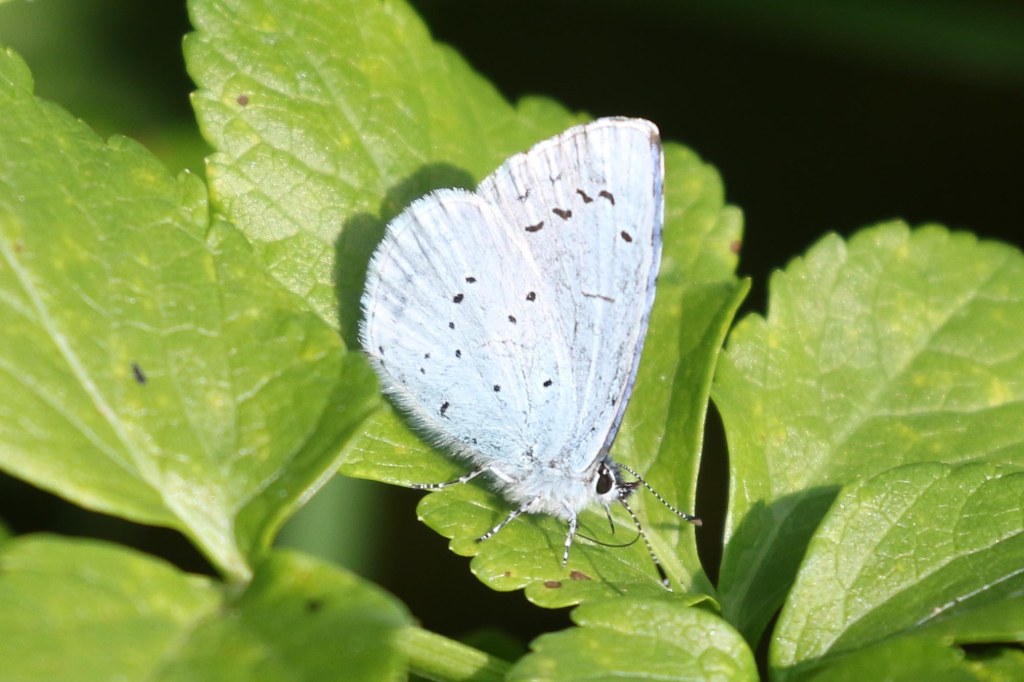
We couldn’t find any Ring Ouzels in the fields here today, but six Wheatears were out on the grass. Migrants stopping off to feed up on their way north. A couple of Marsh Harriers swirled round over the reeds beyond, several Linnets perched on the gorse bushes and flew in and out of the hedge and a Brown Hare was grooming itself out in the field.
From the next gate, we could see lots of Greylag Geese out on the grazing meadows, but a smaller goose with a darker head and bill was a lingering Pink-footed Goose. Most of the birds which had spent the winter here have long since departed, on their way back to Iceland for the breeding season. There are normally a handful which spend the whole year here though, typically inured birds which cannot make the journey north.
There was a succession Sedge Warblers singing in the brambles and reeds by the path, as we continued on. They seem to have divided up the path into various territories between them, each one singing and song flighting to advertise its own patch. One or two perched up nicely for us to have a closer look. A Cetti’s Warbler had not read the manual – rather than lurking deep in the vegetation it came out to sing perched right in the open on a briar stem. Unusually good views of this normally very secretive species.
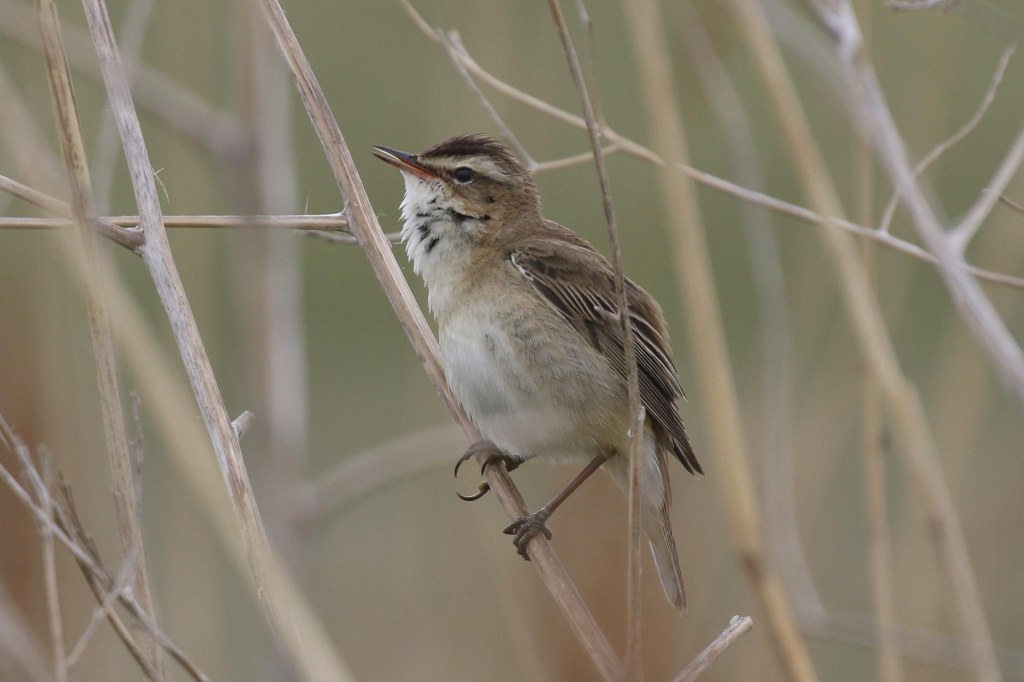
Stopping to scan the pools, there were several Avocets and we turned the scope on one of the Lapwings for a closer look – such stunning birds! A couple of Black-tailed Godwits were sleeping further along, and a Common Snipe flew up from in front of us and dropped back down out of view. There were a few ducks here too, and a Little Grebe lurking in front of the reeds.
From up on the seawall, we could see the tide was in and the saltmarsh was largely covered with water. There were a few Common Pochard and Tufted Ducks on the reedbed pool and we could hear our first Reed Warbler of the day singing its more rhythmic song down in the reeds below us. There were a couple more Reed Warblers further up, more recent arrivals back from the summer just in the last day or so.
Scanning the remaining exposed area of saltmarsh from a bit further along, a Curlew was roosting between a couple of Oystercatchers and then we found a Whimbrel also asleep nearby – a nice opportunity to compare the two species, even if only the Curlew woke and flashed us its longer bill.

A male Ruff, already moulting its body feathers but yet to get its oversized spring ruff, was feeding round one of the pools on the grazing marsh behind us. A lone Brent Goose was in with the Greylags beyond. It was cool in the breeze up on the bank, so we pushed on towards the shelter of the dunes. A Skylark fluttered up into the blue sky singing and a pair of Reed Buntings were down in the suaeda below the bank.
When we got to the boardwalk, we turned east into the dunes. There were lots more Linnets here and several more Wheatears on the short grass which flicked off ahead of us flashing their white rumps. There were one or two Meadow Pipits here too. A smart male Stonechat perched up on the bushes the other side of the fence, with food in its bill – presumably it had young in the nest somewhere nearby.

As we came over the next ridge, we could see several Ring Ouzels on the grass below us. There was a dogwalker coming towards us though and the Ring Ouzels flew up into the dunes before we could get the scope on them. We walked down and refound them a little further in – again they were very flighty but three landed on the slope ahead of us where we could finally get them in the scope, two browner females and a single male with a bright white gorget.
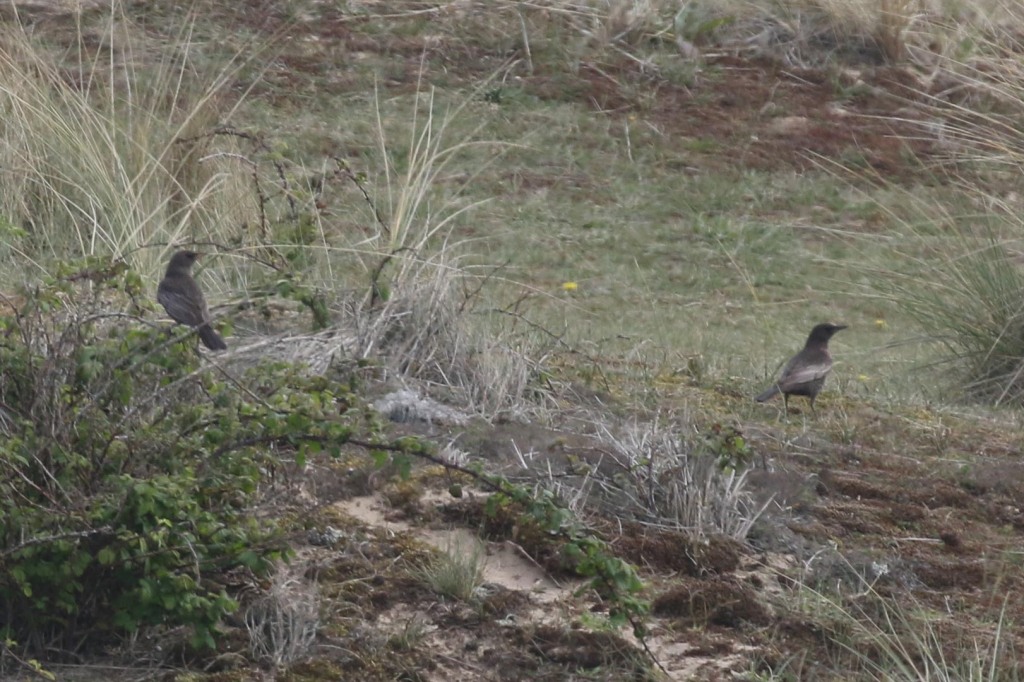
A fourth Ring Ouzel disappeared round behind the next dune. As we walked on, it flew across and landed on the top of a bush the other side of the fence. One of the other Ring Ouzels flew over our heads to join it – two females again. It was hard to tell exactly how many there were here, but there seemed to be fewer than recent days. Perhaps some had left overnight, continuing on their way north up to Scandinavia.
A Grasshopper Warbler reeled briefly from the bushes a bit further along, but we didn’t hear it again, as we continued on through the dunes to the end of the pines. A pair of Mediterranean Gulls flew over calling and disappeared off towards the beach. We had a look around the feet of the cows out on the grazing marshes beyond the fence, but most of them were out of view in the vegetation. We couldn’t see any sign of the Cattle Egrets from here, but we could see that there were more cows further along, north of the pines.
There was a nice selection of invertebrates and plants here in the dunes too. A couple of Small Copper butterflies were notable. Towards the edge of the pines, we found a few bees – several females of the scarce and localised Early Colletes (Colletes cunicularius) still, going into their holes in the sand, and a swarm of smaller male Sandpit Mining Bees (Andrena barbilabris) – plus a single Hairy Sand Wasp (Podolonia hirsuta). The Norfolk Everlasting Pea shoots are just coming up.

We could just see a Spoonbill in the trees in the distance, but there was a lot of heat haze and it was little more than a white blob from here. Everyone seemed happy to walk further, and have a later lunch when we got back, so we pressed on towards Joe Jordan hide. As we headed towards the pines, a Common Whitethroat was singing in the bushes beyond the fence and we could see it in the very top of a large hawthorn.
Along the path by the pines, a couple of Willow Warblers were flitting around in the sunshine in a sycamore which was just coming into leaf, one singing its lovely sweet descending scale of a song. The sound of spring! There were a few tits and more Blackcaps here, as well as a Speckled Wood butterfly.
From up in Joe Jordan hide, we got the scope on a Spoonbill which had flown down to bathe in one of the pools and was now busy preening, shaking its shaggy nuchal crest and showing off the yellow tip to its black bill. A second Spoonbill was feeding in a small pool beyond, sweeping its bill from side to side as it walked through the shallow water. One or two more circled in and out of the trees. Much better views from here, than the one we had seen earlier!
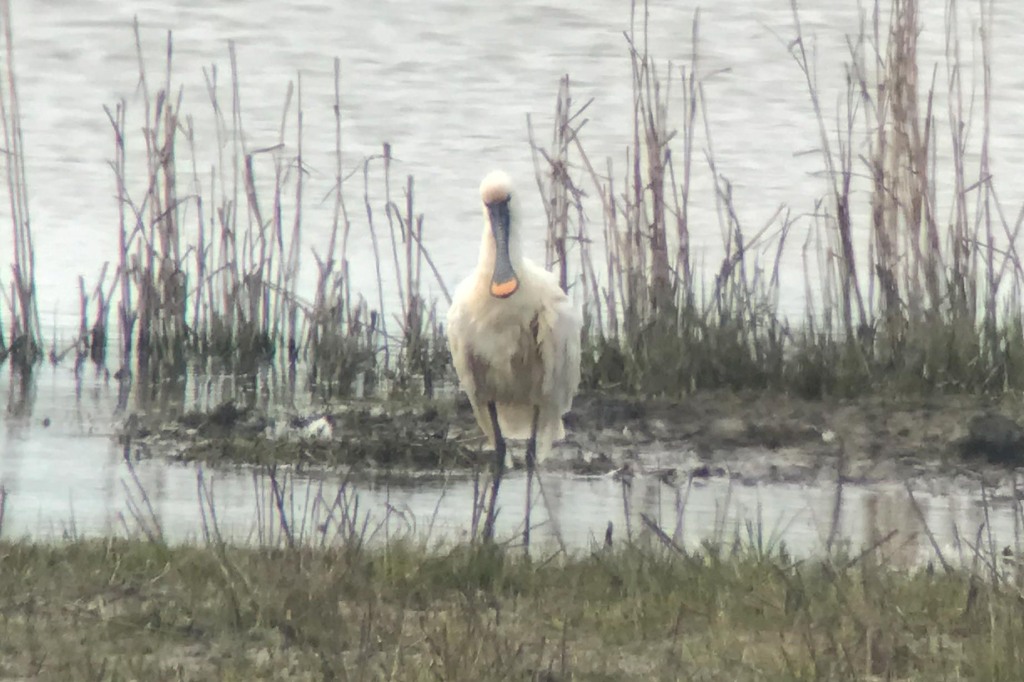
A couple of Cattle Egrets were stalking around the feet of the cows on the far side of the grazing marsh to the west. Through the scope, we could see their yellow bills and some orange colouring on their heads and backs. Hopefully they will stay to join the other egrets and herons in the colony. Three Grey Herons were hanging around with the cows too. A pair of Egyptian Geese were down on the marshes in front.
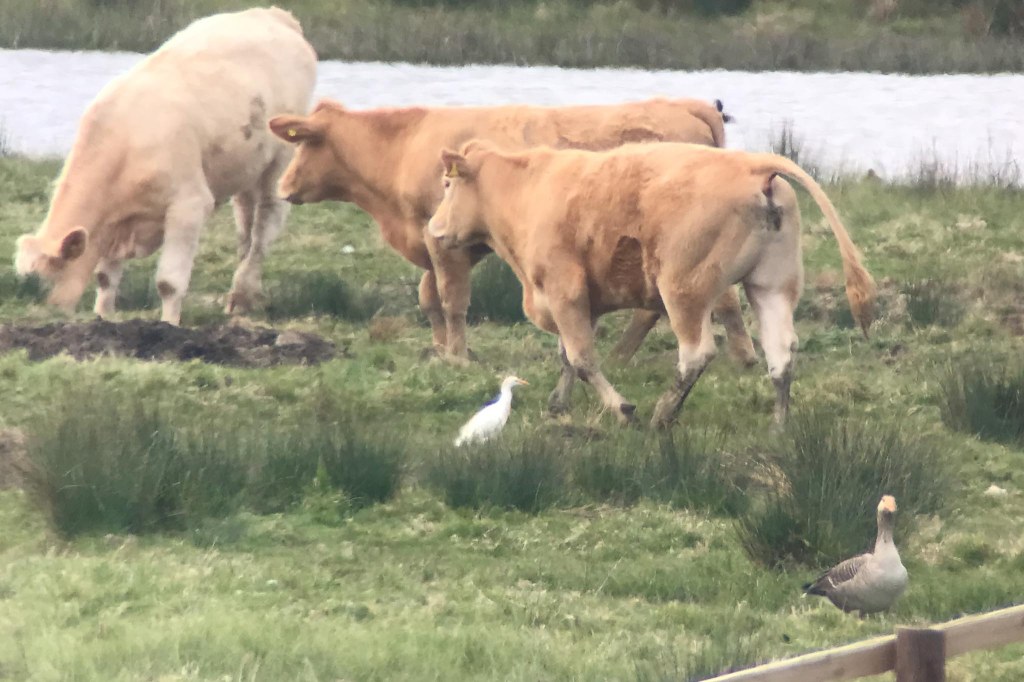
After a short rest in the hide, it was time for the long walk back. A different Willow Warbler by the path was doing a bit of ‘mixed singing’, adding in a little bit of Chiffchaff to the regular Willow Warbler song, presumably just something it learned when it was young. Surprisingly, on our way back through the dunes, we didn’t see any further sign of any Ring Ouzels.
With the tide out, there were more Brent Geese now feeding out on the saltmarsh. A Bittern boomed just three times from somewhere deep in the reedbed and after hearing Bearded Tits calling we had a brief view of one in the tops before it flew off back over the reeds.
It had been a long walk this morning but a very good one. We made our way round to Titchwell now, for a rather later than planned lunch in the picnic area. A couple of Bank Voles were creeping around the bee hotel behind us as we ate. After a welcome sit down and refuel, we headed out to explore the reserve. It had clouded over now and was feeling much cooler in the fresh breeze, so we made our way quite quickly up to Island Hide.
There were lots of gulls on the new bund, a group of very smart adult Mediterranean Gulls in with the Black-headed Gulls. We could see the Mediterranean Gulls‘ blacker hoods, with contrasting white eye shadow, bigger redder bills and white wing tips. Two Sandwich Terns flew round calling and landed in with the gulls briefly – we could see their shaggy crests and yellow-tipped black bills through the scope.
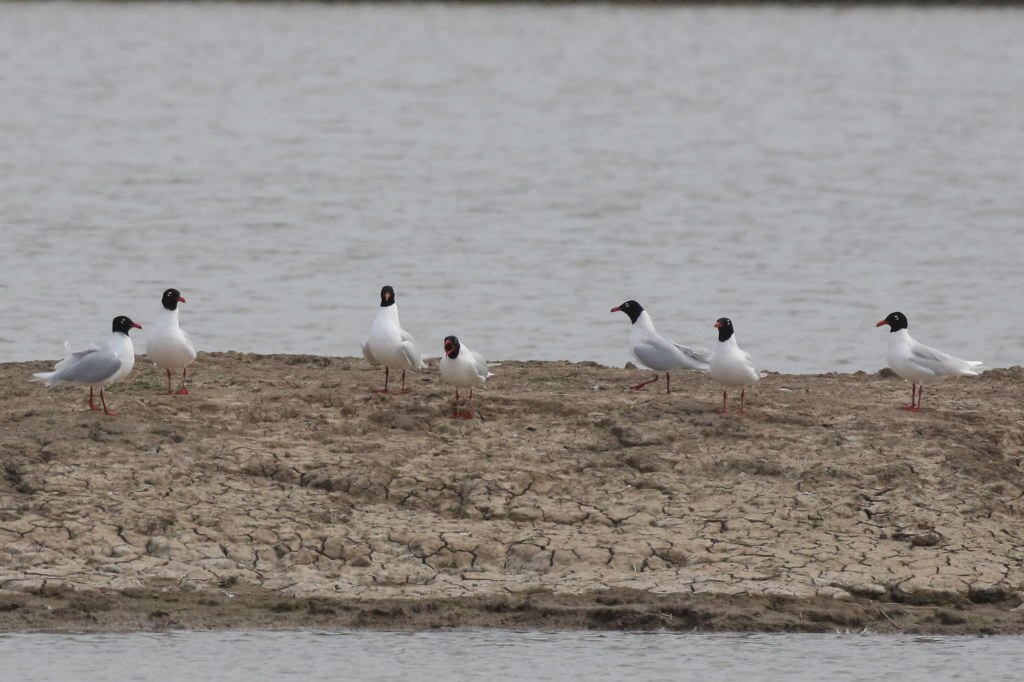
There were nice close views of Avocets feeding in front of the hide and several pairs squabbling and displaying on the nearest island. A Ruff was picking round the edge of the island just behind and two Little Ringed Plovers flew over but dropped down out of view at the back. There were several Little Ringed Plovers on the islands in front of Parrinder hide and we had a nice view from them there, in the scope. We could see their golden yellow eye rings.

A Temminck’s Stint had dropped in here yesterday and thankfully was still hanging around today and we got it in the scope as it picked its way around the edges of the islands. Compared to the Little Ringed Plovers, and a pair of Greylag Geese and goslings which walked past at one point, we could see just how tiny it really was – one of our smallest waders. Temminck’s Stint is a scarce passage migrant here, passing through mainly in spring on its way up to Scandinavia for the breeding season, so always a nice one to see.
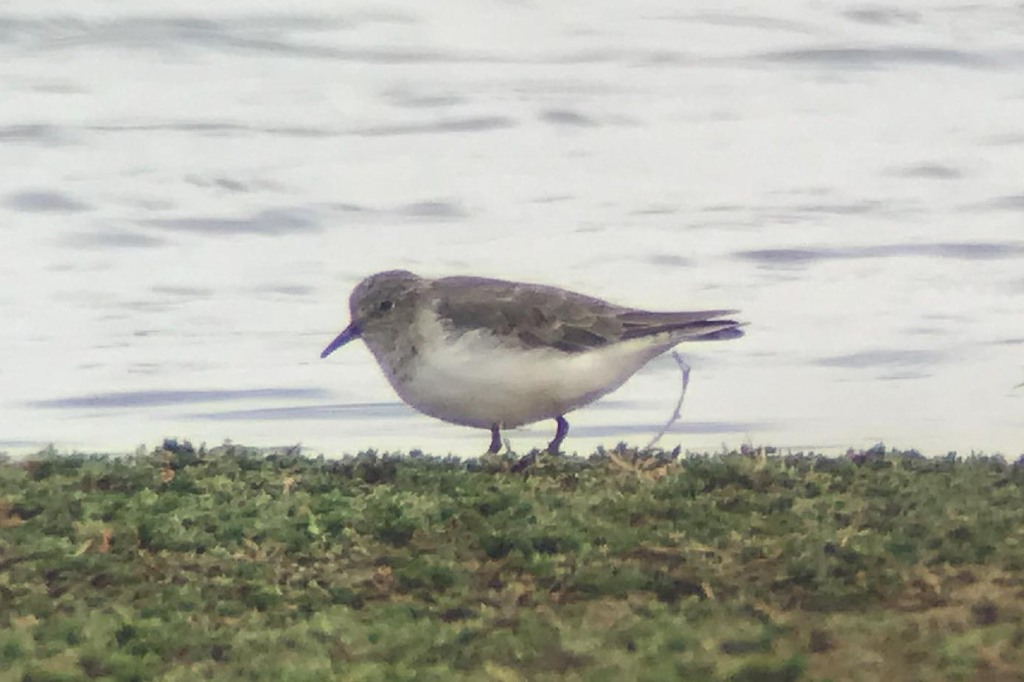
There were a few Ruff here too – several males in various states of moult and a single smaller female ‘Reeve‘. They really are one of the most confusing of waders! We had a good chance to compare them with several Redshank here too.
It looked a bit brighter, so we had a quick walk out to the beach. The tide was out and there was not very much on Volunteer Marsh today, and the Tidal Pool is not draining at the moment so was still full after the tide. Out on the beach, there were some waders down on the mussel beds – Bar-tailed Godwit, Grey Plover, several Turnstone and Oystercatchers. There were more waders distantly along the beach up towards Thornham Point – including a few Dunlin. A single Great Northern Diver was diving just offshore away to the east. It was rather cool out here in the northerly wind and we were out of time, so we turned to head back.
We were almost back to the Visitor Centre when we came across three people looking out through a scope over the Thornham grazing meadow. They were watching a Short-eared Owl which was perched on a post half way out. It had been seen earlier this morning but had gone to roost down in the grass, from where it had just been flushed by a Marsh Harrier apparently and landed on the post. We stopped to look at it through the scope.

A great way to finish, we then made our way back to the minibus and dropped everyone back where we started.
















